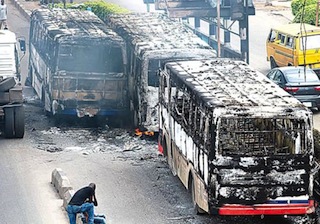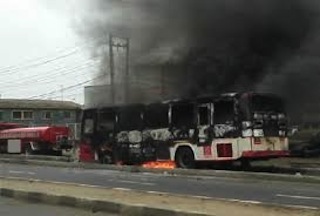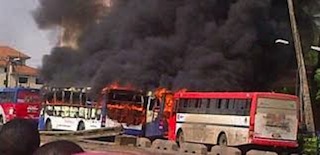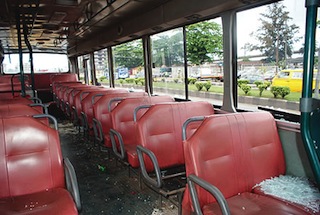8th July, 2014
Kazeem Ugbodaga

Mayhem ensued last Friday at Palmgrove area on Ikorodu Road, Lagos, Southwest Nigeria with officers of the Nigerian Army taking laws into their hands, blocking the road, maltreating passersby and burning eight LAGBUS buses. Windscreens of others were smashed by the soldiers, who were only taken off the road when their Commanding Officer came to the rescue.
The trigger for the riot happened after a military officer, on motor bike was killed by a LAGBUS driver on the dedicated lane of the Bus Rapid Transport(BRT). It was indeed an agonizing day for the commuters, motorists and LAGBUS, the operators of the bus system. LAGBUS, which has been facing numerous challenges, in terms of massive reduction of fleet size, further suffered fleet losses, running into tens of millions of naira. It was a lot of money going down the drain, just like the grand dream of LAGBUS itself.
An unhappy Governor Babatunde Fashola condemned the act, describing it as irresponsible for military officers, being paid and sustained with tax payers’ money to be destroying public properties under the guise that one of their colleagues had been killed.

“I remember in 2006 when soldiers stormed barracks and set the place ablaze, that is the Area ‘C’ Police Command. We just managed to reconstruct the command. If buses that citizens are complaining that were not enough are set ablaze, I do not know how setting ablaze buses recompense any injury that one may have suffered. I do not know how damaging public property is the restitution for the any injury that may have come,” he lamented.
LAGBUS had in the past borne the brunt of public anger whenever there is a skirmish between road users, transporters and officers of the Lagos State Traffic Management Authority, LASTMA. When students take to the streets, LAGBUS buses are sometimes targeted for destruction, when matters get out of hand. At Times, Street urchins take special pleasure in burning these mass transit buses as a way of getting back at the government.
The whole idea of LAGBUS, conceived by the Bola Tinubu administration eight years ago, faces thorny issues threatening its existence.
At the moment, over 250 of the buses are currently off the road due to maintenance problems and sometimes, the cavalier manner some of the drivers handle them.
The LAGBUS is being managed by the LAGBUS Asset Management Limited inaugurated in 2006 by the former Governor Asiwaju Bola Tinubu at a well attended ceremony in Tafawa Balewa Square, Lagos with Oba Rilwan Akiolu, lending his majestic presence. Other witnesses at the ceremony were then deputy governor, Femi Pedro and Babatunde Fashola, then chief of staff .
LAGBUS emerged from the ashes of similar government run public bus services in the state, the last being the LMTS, which the Jakande administration allowed to die in the early 80s.
The objective of the new bus system was to provide mass transit for Lagosians at affordable cost in order to phase out rickety ‘Molues’ and ‘Danfos’ off Lagos highways and expressways. The LAGBUS’ mission is to create a modern, secure and sustainable bus transportation service designed for the special needs of Lagos by using the best practices while creating opportunities for all stakeholders and be a model for others. LAGBUS service can be distinguished from other BRT buses in that its buses were painted in all red as against all blue for LAMATA.
The vision was to deploy buses in dedicated right of way with prepaid tickets, select operators and GPS monitoring to create a modern bus transportation system for Lagos. The pilot scheme ran from Berger to CMS, under the BRT.
Forty routes are currently in operation as the scheme operates a prepaid and on-the-bus ticketing service available in different denominations on different routes. .
As stakeholders agreed then, the success of the scheme will depend on the expertise of the people, a uniform service, high standards and full compliance. At the moment, all those values are in jeopardy.
To begin with, many of the buses under LAGBUS are grounded, because of maintenance problems.
In April, Sola Oni, the Maintenance manager said 220 buses had been withdrawn for overhauling at various maintenance depots in Bolade, Keffi, Ikorodu and Ketu Toll Gate.

“We have challenges of spare parts. You know, we do not produce spare parts here in Nigeria and we have to rely on the ones coming in from abroad and that can take time because when it even arrives, there is a period of time it takes to clear at the ports,” Oni told a training programme for maintenance personnel.
Recently, Fashola met with LAGBUS and BRT bus captains and pilots to find ways of addressing the numerous and incessant breakdown of the vehicles, urging them to show dedication and passion towards their jobs as the only means to grow the model transportation business and show more sensitivity to the feelings of commuters in the State.
The Governor, who said the meeting had become expedient because of the feedbacks from the public concerning the operation of the buses, told them, “No matter how poorly paid the job is, no matter how you feel about the welfare package, this is where you wake up to every morning for now. If only for that reason, give it all you have.”
Fashola expressed regrets at the growing number of breakdown being recorded in the fleet of the mass transit buses, saying as a result of the unique national problem of not having the capacity to make the buses in the country, the first option was to run the buses aground and buy new ones, adding that although it was possible, it was not the best option.
“I do not believe that it is the way to go. So, for now, we are trying to bring back all the buses that are not on the road because each bus that is not on the road means that one bus Captain and one Pilot are not at work. We may get to a situation where really if the bus is not moving, we won’t pay. We may only pay not per month but per functionality. And we are designing those systems now where those who are doing the work will get the reward while those who are content with keeping their buses in the bus yard will go and wait at home until when the bus is operational. Driving the bus dangerously, damaging them does not help our cause.”
The governor pleaded with Lagos commuters to bear with government over the growing scarcity of the buses as a result of breakdowns, admitting that over 200 LAGBUS had broken down and needed to be put back to use.
“We want to turn around the capacity to maintain those buses instead of just taking them and abandoning them and buying new ones. For the Government-run LAGBUS, we have about 70 back on and there is plan to get another 200 back on the road. When we have all our buses running efficiently, then we can plan re-fleeting.
“And we are working on how to optimise the maintenance services and how to expand it because; the numbers of buses are growing. Since we don’t manufacture all the buses here, there are time laps between replacement when you import and before you can clear them,” he explained, adding that all these were however, not excuses as it was the responsibility of government to find solutions to the challenges faced by LAGBUS service, but noted that it is difficult to run a LAGBUS economy in an environment that did not manufacture one, stressing that “these are the challenges, there is a longer reaction time to the service required.”
To address the crisis on ground, the Lagos State Government earmarks N1 billion in this year’s budget to purchase additional buses and repair broken down ones. The new buses will be added to the fleet of the LAGBUS Asset Management Limited.
Managing Director, LAGBUS Asset Management Limited, Babatunde Disu said that the government would certainly acquire new buses this year to add to the fleet of the existing one. He stated the government had in mind the type of buses to acquire and that it would be one that met with the needed specification.
Disu said in the meantime, the government had a plan to aggressively carry out maintenance of the damaged buses so that they could be put into use on time for Lagosians to access to them, adding that in the next few months, aggressive maintenance of the broken down buses would begin in earnest as LAGBUS is bent on delivering qualitative service to the people of Lagos.
Head of Operation, LAGBUS, Olubodun Ogunyankin disclosed that the agency was putting finishing touches to the repair of 180 buses, saying that new engines for the buses had arrived the country and that in the next few weeks, the buses would get back to the road.
Marketing Manager, LAGBUS, Toun Gaji added that in the last five months, 40 buses had been overhauled and put back on the road, re-echoing her colleagues stance that 180 buses would soon be put back to use on the road.
According to her, “we will keep repairing these buses. We are not sitting down, work is ongoing. We are service providers and we want to give the best.”




